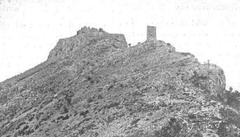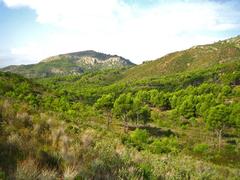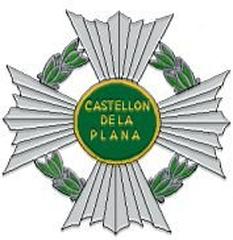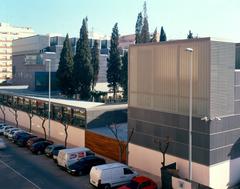Castelló Cathedral: Visiting Hours, Tickets, and Historical Sites in Castelló de la Plana
Date: 15/06/2025
Introduction
Nestled in the vibrant heart of Castelló de la Plana, Spain, the Concatedral de Santa María—commonly known as Castelló Cathedral—is a powerful emblem of the city’s rich history, spiritual life, and cultural legacy. Originating in the 13th century after the Christian Reconquista, the cathedral bears witness to centuries of architectural evolution, community resilience, and artistic achievement. Today, it stands as a living monument where Gothic origins blend harmoniously with later Renaissance and Baroque influences, and where local traditions and modern tourism converge. This comprehensive guide explores Castelló Cathedral’s visiting hours, ticketing options, accessibility, nearby attractions, and its enduring role within Valencian heritage (hollymelody.com, turismodecastellon.com, Comunitat Valenciana).
Table of Contents
- Historical Background and Development
- Architectural Features and Artistic Heritage
- Restoration and Preservation
- The Cathedral in Civic and Religious Life
- Visitor Information
- Nearby Attractions
- Frequently Asked Questions (FAQ)
- Conclusion and Further Resources
Historical Background and Development
The roots of Castelló Cathedral reach back to the late 13th or early 14th century, shortly after the Christian reconquest led by King James I of Aragon. The original church was dedicated to Saint Mary, reflecting the Marian devotion of the era and quickly establishing itself as the spiritual center of the newly Christianized city (hollymelody.com, Comunitat Valenciana).
A catastrophic fire in the 15th century necessitated a complete reconstruction, resulting in the elegant Valencian Gothic structure that would define the cathedral for centuries. This was followed by successive additions and restorations, with the most significant challenge arising during the Spanish Civil War in the 20th century, when the cathedral was severely damaged and subsequently rebuilt. The current building, completed in 2001, carefully preserves surviving medieval elements while integrating modern construction techniques (turismodecastellon.com, Spain.info).
Architectural Features and Artistic Heritage
Exterior: Façade and Towers
The cathedral’s exterior is a striking example of Valencian Gothic architecture, characterized by robust stonework, pointed arches, and three impressive Gothic portals. The oldest portal is located on Calle Arcipreste Balaguer, while another faces Plaza de la Hierba, adorned with vegetal motifs. The main entrance reflects more advanced Gothic elements, showcasing the region’s evolving architectural language (turismodecastellon.com).
Adjacent to the cathedral stands El Fadri, the iconic 15th-century octagonal bell tower. Separate from the main church, this 58-meter tower is both a masterpiece of late Gothic design and a symbol of Castelló’s civic pride (Tourist Places Guide).
Interior: Layout and Sacred Art
Inside, the cathedral follows a Latin cross plan, with a spacious nave, side aisles, and a transept. The ribbed vaults and slender columns create a soaring, contemplative atmosphere. Natural light streams through stained glass windows, illuminating religious artworks and Baroque sculptures, including an 18th-century image of the Immaculate Conception and a painting by Ribalta. The treasury contains precious metal liturgical objects and other sacred art, attesting to the cathedral’s longstanding ecclesiastical significance (Spain.info).
Restoration and Preservation
Castelló Cathedral’s history of destruction and rebuilding—most notably during and after the Spanish Civil War—has made it a symbol of resilience. The most recent restoration prioritized historical accuracy, integrating reinforced concrete and steel to support ancient stonework while preserving original Gothic portals and decorative elements. Ongoing conservation efforts ensure the cathedral’s continued vitality as both a religious and tourist destination (Comunitat Valenciana, Wikipedia).
The Cathedral in Civic and Religious Life
As the principal Catholic church of Castelló de la Plana, the cathedral is central to community life. It hosts daily Masses, sacraments, and significant liturgical celebrations such as Easter, Christmas, and the Feast of the Assumption. The annual Magdalena Festivities see the cathedral at the heart of processions, music, and communal gatherings, with El Fadri’s bells marking key moments (Castellón Turismo).
Beyond its religious function, the cathedral is a venue for concerts, social outreach, educational programs, and civic ceremonies, reflecting its broader cultural role.
Visitor Information
Visiting Hours
- Monday to Saturday: 10:00 AM–1:30 PM and 5:00 PM–7:30 or 8:00 PM
- Sundays: 11:00 AM–1:30 PM
Hours may vary during religious services, special events, or holidays. For the most current schedule, consult the official tourism website.
Tickets and Guided Tours
- Admission: Generally free.
- Guided Tours: Available in Spanish, and sometimes in English and French upon request. A modest fee may apply for special tours or exhibitions. Advance booking is recommended during peak seasons.
- Self-Guided Options: Brochures and QR codes for digital guides are often available at the entrance (Tripomatic).
Accessibility and Visitor Facilities
- Wheelchair Access: Ramps and adapted facilities ensure accessibility at the main entrances.
- Restrooms: Not available within the cathedral, but public facilities and cafés are nearby at Plaza Mayor.
- Other Amenities: No luggage storage; visitors should plan accordingly.
Visitor Etiquette and Practical Tips
- Dress Code: Shoulders and knees should be covered; hats removed inside (Taylor on a Trip).
- Photography: Allowed in most areas, but avoid flash and respect restrictions during services.
- Best Times to Visit: Early mornings or late afternoons for quieter visits; spring and autumn offer pleasant weather and fewer crowds (Wintersun Expert).
- Safety: Castellón de la Plana is generally safe, but standard precautions are advised (Travel with the Greens).
Nearby Attractions
- El Fadri Bell Tower: Climb its 200 steps for panoramic city views.
- Plaza Mayor: The lively square surrounding the cathedral.
- Central Market: Sample local produce and crafts.
- Town Hall and Museums: Explore additional facets of Castelló’s history and culture.
- Mediterranean Beaches: Accessible for relaxation after your cultural tour.
Combine your cathedral visit with a walking tour through Castelló’s compact, historic city center (Travel with the Greens).
Frequently Asked Questions (FAQ)
What are the Castelló Cathedral visiting hours?
Typically Monday–Saturday 10:00–13:30 and 17:00–19:30/20:00, Sunday 11:00–13:30. Check official site for updates.
Is there an entrance fee or do I need a ticket?
General entry is free; guided tours or special exhibits may require tickets.
Are guided tours available in English?
Primarily in Spanish, but English and French may be available with advance request.
Is the cathedral wheelchair accessible?
Yes, main entrances have ramps and facilities for visitors with reduced mobility.
Can I take photos inside?
Photography is generally permitted outside service times and in non-restricted areas; avoid flash.
What other historical sites are nearby?
El Fadri bell tower, Central Market, Town Hall, and several museums.
Conclusion and Further Resources
Castelló Cathedral is a testament to the city’s enduring faith, resilience, and cultural vibrancy. Its layered architecture, sacred art, and central role in community life make it a must-visit for anyone exploring Castelló de la Plana or the Valencian region. For an enriched experience, consider guided tours, explore nearby attractions, and engage with digital resources such as the Audiala app for maps and up-to-date visitor information.
To delve deeper, visit the following resources:
Plan your visit, respect the cathedral’s sacred atmosphere, and immerse yourself in the living history of Castelló de la Plana.




